Total lunar eclipse: 10 December 2011

THIS WEEKEND, THE EARTH will move between the Moon and the Sun, causing the last total lunar eclipse until April 2014.
From Asia to Australia, the Moon will noticeably darken and flare different colours as the Earth blocks the Sun’s rays, refracting light through its own atmosphere and colouring the Moon much like the horizon during a sunrise or sunset – a phenomenon known as Rayleigh scattering, the same process that turns the sky blue.
Partial lunar eclipses are reasonably common: there are at least two per year, but total ones are rarer. And they are easy to enjoy – unlike a solar eclipse, which can only be seen from a small part of the world at a time, a lunar eclipse is visible from everywhere on the night side of the Earth, and can last for a few hours, instead of the brief few minutes the Moon obscures the Sun in a solar eclipse.
Lunar eclipse viewing not harmful to eyes
“Lunar eclipses are nice leisurely events; you can take your time and enjoy them,” says Dr Tanya Hill, Astronomer for the Melbourne Planetarium at Scienceworks. Unlike a solar eclipse, you don’t need any protective equipment or even a telescope. You can take your time, and view it from anywhere – provided it is during the night.
This particular eclipse will have 51 minutes of totality – that is, almost an hour when the Earth is completely eclipsing the Moon, and the whole eclipse from start to finish will take about 3.5 hours.
The total eclipse will be visible high in the sky, all across Australia.
And what is remarkable, Tanya says, is that as the Earth’s shadow moves across the Moon, “you are seeing how we are moving through space.” It’s easy to forget we are hurtling along our orbit at 30km/s, or 108,000km/h.
Total eclipse an array of colours
While it is difficult to forecast, astronomers are predicting a blue pinch to the Moon’s changing colour as the Earth crosses the alignment.
“The shadow will be very dark,” Tanya says, “it could redden, and could also have a bluish turquoise hue to it too.” But it all depends on the Earth’s atmosphere.
Make sure your eyes are peeled for the eclipse, beginning its partial eclipse at 11:46pm in Melbourne, Sydney and Canberra (AEDT) on Saturday. The total eclipse begins at 1:06am and lasts for nearly an hour.
For more information on events in the night sky or astronomical anniversaries visit the Melbourne Planetarium’s Skynotes website.
RELATED STORIES

